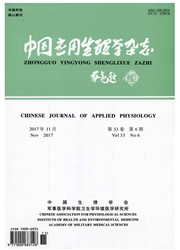

 中文摘要:
中文摘要:
目的:探讨一次性力竭运动诱导的氧化应激反应对大鼠红细胞的抗氧化能力和细胞变形性的影响。方法:大鼠分为3组(n=10):对照组(Control)、适度运动组(MRE)和力竭运动组(ERE)。力竭运动组大鼠运动的前20 min保持5%的坡度和20 m/min的速度,20 min后调整为15%的坡度和25 m/min的速度,直至运动力竭。适度运动组大鼠在5%的坡度和20 m/min的速度下跑40 min。检测各组大鼠红细胞的抗氧化能力,并对氧化应激反应诱导的红细胞膜蛋白巯基水平、膜脂质过氧化水平和膜蛋白SDS-Page电泳条带变化进行了分析。通过激光衍射法对不同运动组大鼠红细胞变形性进行了检测。结果:力竭运动条件下大鼠红细胞受到严重的氧化应激损伤,红细胞内抗氧化能力下降。导致膜脂质过氧化损伤和膜蛋白巯基交联为主的蛋白聚簇化,形成高分子聚合物(HMW)。力竭组大鼠红细胞变形性(0.314±0.013 at 3 Pa and 0.534±0.009 at 30 Pa)显著低于对照组(0.41±0.01 at 3 Pa and 0.571±0.008 at 30 Pa;P〈0.05 and P〈0.01,respectively)和适度运动组。结论:力竭运动诱导的氧化损伤导致了红细胞变形能力(EI)的显著下降,使红细胞在微循环的转运受到限制,导致组织缺血缺氧进而引起休克、死亡等运动性疾病。
 英文摘要:
英文摘要:
Objective: The aim of the present study is to explore the effects of exhaustive exercise-induced oxidative stress on the antioxidant capacity and diformability of rat red blood cells. Methods: Rats were divided into three group ( n = 10) : sedentary control(C) , exhaus- tive running exercise (ERE) and moderate running exercise (MRE) groups. Animals in the ERE group started treadmill running at a speed of 20 m/min speed with a 5% gradient, and reached a speed of 25 m/min with gradient 15% in 20 min. Running was continued until exhaustion. MRE group rats nmning at a speed of 20 m/min with a 5% gradient for 40 min. The levels of free thiol in erythroeyte membrane protein, lipidperoxidation levels and membrane protein components were analyzed. The red blood cell deformability of different groups was also observed. Results: The results showed that red blood cells were damaged by severe oxidative stress and the anti-oxidative capacity decreased significantly under exhaustive exercise conditions. Besides, lipid peroxidation and protein sulflaydryl cross-link based clustering of membrane were found after exhaustive exercise, and polymers high molecular weight(HMW) was formed. The elongation index (EI) was found to decline significantly in the ERE group compared with the C and MRE groups under shear stress (control group, 0.41 ± 0.01 at 3 Pa and 0.571± 0.008 at 30 Pa; ERE group, 0.314 ± 0.013 at 3 Pa and 0.534 ± 0.009 at 30 Pa; P 〈 0.05 and P 〈 0.01, respectively). Conclusion: These exercise-induced oxidative injure result in a significant decrease in deformability of rat erythrocytes, which in turn leads to dysfunction in the microcirculatory.
 同期刊论文项目
同期刊论文项目
 同项目期刊论文
同项目期刊论文
 In vitro kinetics of oxygen transport in erythrocyte suspension or unmodified hemoglobin solution fr
In vitro kinetics of oxygen transport in erythrocyte suspension or unmodified hemoglobin solution fr Cluster of erythrocyte band 3: a potential molecular target of exhaustive exercise-induced dysfuncti
Cluster of erythrocyte band 3: a potential molecular target of exhaustive exercise-induced dysfuncti 期刊信息
期刊信息
